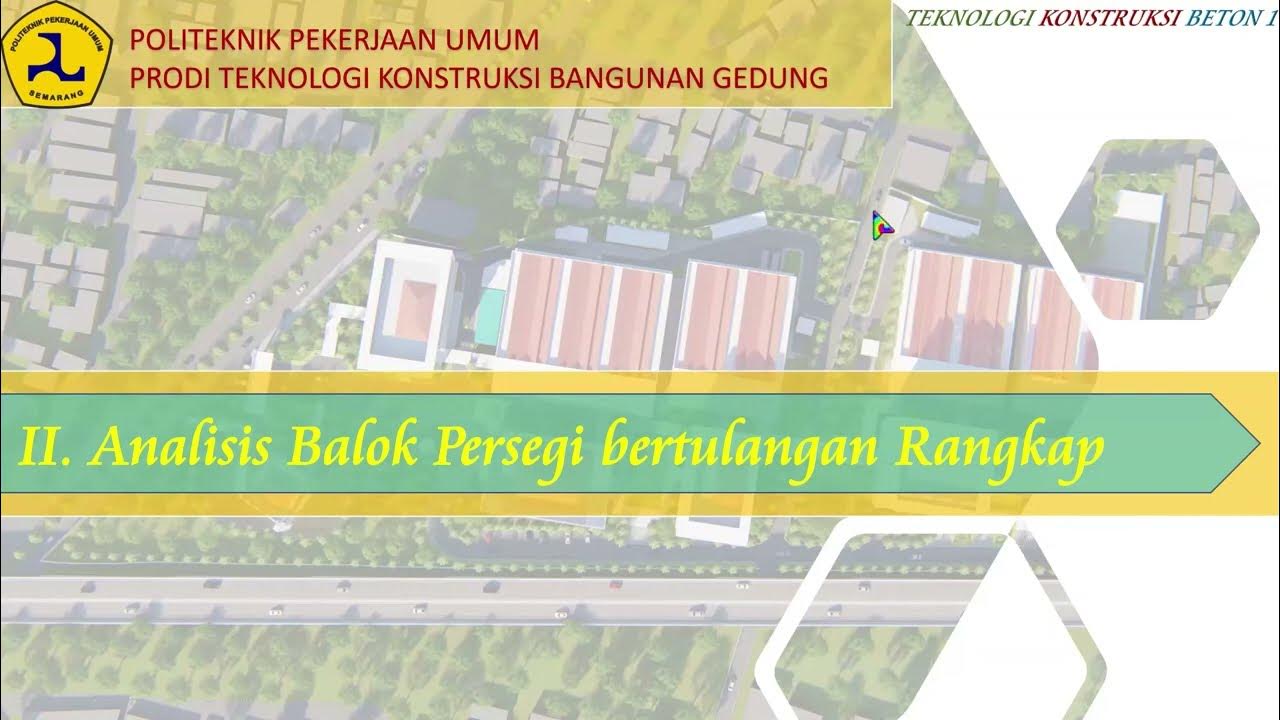1. Kupas Tuntas Teknologi Beton
Summary
TLDRIn this video, Agus Setiawan provides a comprehensive introduction to reinforced concrete structures. He begins by explaining the essential components of concrete—cement, aggregates, and water—while also delving into the role of admixtures to enhance its properties. The script covers various types of cement and their specific applications, alongside an overview of concrete's mechanical properties such as compressive strength, tensile strength, and shrinkage. Setiawan emphasizes the importance of understanding concrete's composition and properties for structural design, highlighting both the advantages and challenges of using concrete in construction.
Takeaways
- 😀 Beton (concrete) is one of the most widely used construction materials in the world, made from a mixture of cement, aggregates (sand and gravel), and water.
- 😀 The quality and strength of concrete depend on the mix ratio, with a typical water-to-cement ratio ranging from 0.4 to 0.6 for normal concrete.
- 😀 The manufacturing process of cement involves mixing limestone, clay, and gypsum, which is then heated to create clinker, forming the basis for cement production.
- 😀 There are five main types of cement, each suited for different construction needs, including ordinary, low-heat, high-early strength, and sulfate-resistant cement.
- 😀 Aggregates, both fine (sand) and coarse (gravel), make up 70-75% of the volume of concrete, and their size is strictly regulated to ensure structural integrity.
- 😀 The hydration reaction between cement and water forms calcium silicate hydrate (CSH), which is key to the strength development of concrete.
- 😀 Admixtures can be added to concrete to improve properties, such as increasing workability, durability, or accelerating curing time.
- 😀 One of the primary mechanical properties of concrete is its compressive strength, which is tested by crushing cylindrical concrete samples.
- 😀 Concrete has low tensile strength, which can lead to cracking under tension, making it essential to reinforce concrete with steel rebar for strength.
- 😀 Curing is crucial to prevent cracking and ensure the concrete achieves its desired strength, involving methods like water spraying or covering with wet cloths.
- 😀 Concrete structures are generally more cost-effective and require less skilled labor than steel structures, though they are heavier and more prone to shrinkage-related cracks.
Q & A
What are the main components of concrete?
-Concrete is composed of cement, fine aggregates (sand), coarse aggregates (gravel or crushed stone), and water. Sometimes, admixtures are added to improve the properties of the concrete.
What role does cement play in concrete?
-Cement is the binding material in concrete. When mixed with water, it undergoes a chemical reaction called hydration, forming calcium silicate hydrate (CSH), which is responsible for the concrete's compressive strength.
What are the different types of cement, and how do they differ?
-There are five types of cement: Type 1 (ordinary cement for general use), Type 2 (resistant to sulfate attack), Type 3 (high early strength), Type 4 (low heat of hydration), and Type 5 (resistant to sulfate attack in severe conditions). Each type has different properties suited for specific construction needs.
What is the importance of the water-to-cement ratio in concrete?
-The water-to-cement ratio (often referred to as the water-cement ratio) is crucial because it determines the workability and strength of the concrete. A lower ratio results in stronger concrete, while a higher ratio may lead to weaker concrete with more voids.
How do aggregates influence the properties of concrete?
-Aggregates make up 70-75% of the concrete's volume. The size and quality of aggregates impact the strength, durability, and workability of concrete. Fine aggregates fill gaps between coarse aggregates, while coarse aggregates provide bulk and strength.
What is the significance of curing in concrete construction?
-Curing is essential to ensure proper hydration of cement, which helps the concrete achieve its desired strength and durability. Without proper curing, concrete may shrink, crack, and fail to reach its full potential.
What is hydration in concrete, and why is it important?
-Hydration is the chemical reaction between cement and water, producing heat and forming calcium silicate hydrate (CSH), which strengthens the concrete. This process is crucial for the development of concrete's strength over time.
What are the mechanical properties of hardened concrete mentioned in the script?
-The key mechanical properties of hardened concrete include compressive strength (FC), tensile strength (fsp), modulus of elasticity, and flexural strength. These properties are vital for structural design and performance.
What are some potential weaknesses of concrete?
-Concrete has low tensile strength, meaning it is prone to cracking under tension. It also has variability in final strength, which can be influenced by factors like material quality and mixing processes.
What is the effect of shrinkage in concrete, and how can it be managed?
-Shrinkage occurs as water evaporates from concrete, causing it to contract and potentially crack. This can be managed by proper curing methods, such as keeping the concrete moist during the curing period, which helps prevent premature drying and cracking.
Outlines

Этот раздел доступен только подписчикам платных тарифов. Пожалуйста, перейдите на платный тариф для доступа.
Перейти на платный тарифMindmap

Этот раздел доступен только подписчикам платных тарифов. Пожалуйста, перейдите на платный тариф для доступа.
Перейти на платный тарифKeywords

Этот раздел доступен только подписчикам платных тарифов. Пожалуйста, перейдите на платный тариф для доступа.
Перейти на платный тарифHighlights

Этот раздел доступен только подписчикам платных тарифов. Пожалуйста, перейдите на платный тариф для доступа.
Перейти на платный тарифTranscripts

Этот раздел доступен только подписчикам платных тарифов. Пожалуйста, перейдите на платный тариф для доступа.
Перейти на платный тарифПосмотреть больше похожих видео

8. Pembebanan Pelat 2 Arah

3. Metode Direct Design Method

Structural Theory 1 Chapter 1 Part II (with Subtitles)

Desain Pelat 2 Arah Beton Bertulang - Part 1 Konsep SNI 2847-2019

3 2 ANALIS DAN DESAIN LENTUR BALOK PERSEGI BERTULANGAN RANGKAP ANALISIS LENTUR

V11.1 Statis Tak Tentu - Force Method untuk Truss System
5.0 / 5 (0 votes)
